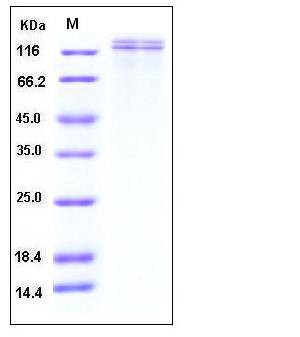Human VLDLR / VLDL Receptor Protein (His Tag)
CAMRQ1,CARMQ1,CHRMQ1,VLDLRCH
- 100ug (NPP4389) Please inquiry
| Catalog Number | P11075-H08H |
|---|---|
| Organism Species | Human |
| Host | Human Cells |
| Synonyms | CAMRQ1,CARMQ1,CHRMQ1,VLDLRCH |
| Molecular Weight | The recombinant human VLDLR comprises 781 amino acids with a predicted molecular mass of 86 kDa. It migrates with the apparent molecular weight of 150 & 180 kDa due to different glycosylation in SDS-PAGE under reducing conditions. |
| predicted N | Gly 28 |
| SDS-PAGE |  |
| Purity | > 95 % as determined by SDS-PAGE |
| Protein Construction | A DNA sequence encoding the human VLDLR isoform alpha (NP_003374.3) extracellular domain (Met 1-Ser 797) was fused with a polyhistidine tag at the C-terminus. |
| Bio-activity | |
| Research Area | Immunology |Signal Transduction |Protein Trafficking |Vesicle Transport |Coat Proteins |
| Formulation | Lyophilized from sterile PBS, pH 7.4 1. Normally 5 % - 8 % trehalose, mannitol and 0.01% Tween80 are added as protectants before lyophilization. Specific concentrations are included in the hardcopy of COA. |
| Background | The very low density lipoprotein receptor, known as VLDLR, is a single-pass type 1 integral membrance protein and a member of the LDL receptor family. This receptor family includes LDL receptor, LRP, megalin, VLDLR and ApoER2, and is characterized by a cluster of cysteine-rich class A repeats, epidermal growth factor (EGF)-like repeats, YWTD repeats and an O-linked sugar domain. VLDLR contains 3 EGF-like domains, 8 LDL-receptor class A domains, as well as 6 LDL-receptor class B repeats, and is abundant in heart, skeletal muscle, also ovary and kidney, but not in liver. VLDLR binds VLDL and transports it into cells by endocytosis. In order to be internalized, the receptor-ligand complexes must first cluster into clathrin-coated pits. VLDLR mediates the phosphorylation of mDab1 (mammalian disabled protein) via binding to Reelin, and induces the modulation of Tau phosphorylation. This pathway regulates the migration of neurons along the radial glial fiber network during brain development. Defects of VLDLR may be the cause of VLDLR-associated cerebellar hypoplasia (VLDLRCH), a syndrome characterized by moderate-to-profound mental retardation, delayed ambulation, and predominantly truncal ataxia. |
| Reference |
